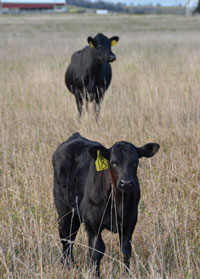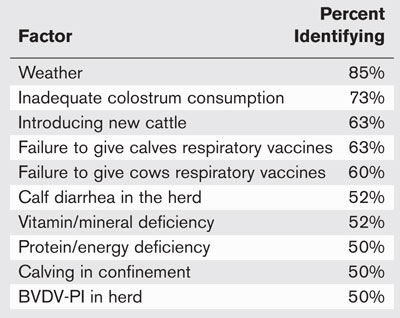Nursing Calf BRD
Veterinarians seek ways to reduce the incidence of the disease claiming 16% of calves on the ranch
Despite advancements in nutrition, genetics and management, producers and veterinarians remain frustrated by bovine respiratory disease (BRD). It’s the most common cause of death for all production classes of cattle and calves, resulting in estimated industry losses of $650 million to possibly $1 billion annually.
The costs are difficult to quantify since even calves successfully treated for BRD might never perform up to their pre-illness potential. Those performance losses are encouraging more research on preventing and treating BRD in feedlot cattle, yet relatively little attention has targeted BRD in nursing calves.
Management, transportation and commingling of feedlot cattle plays a major role in the incidence of BRD, but only recently have veterinarians launched widespread studies to identify the management-related BRD risk factors for nursing calves in cow-calf operations.
“That lack of information is important because respiratory disease is the most common cause of death for calves greater than three weeks old in U.S. cow-calf operations,” says Amelia Woolums, DVM, University of Georgia. “BRD is responsible for the deaths of 16% of calves that are born on cow-calf operations.”
Woolums and veterinarians from several universities in the Southeast and Midwest are collaborating in a
research project to determine herd-level risk factors for BRD in nursing beef calves. The initial study, released in 2012, was a survey of cow-calf producers in two U.S. calf-producing regions—three eastern states and three Plains states—to identify risk factors for BRD in nursing beef calves. Twenty-one of 35 variables evaluated in the survey had an association with BRD in calves.
“Many of the variables were associated with the number of animals in a herd, which was also a predictor variable of BRD in calves,” Woolums says.
The factors associated with detection of BRD in calves include herd size, detection of diarrhea and treatment of cows for respiratory disease. Differences did emerge by region. For operations in the Plains region but not for operations in the Eastern region, calving season duration was also a factor.
“The management practices we found to be associated with development of BRD in calves or cumulative BRD treatment incidence cannot be assumed to be causative, although some of them may be,” she says.
“Our ongoing research is aimed at identifying whether modification of management practices
associated with those risk factors can decrease BRD in nursing calves,” Woolums says.
Moving forward, she says it’s possible the factors identified in the studies to date are actually not the things that need to be changed, “but instead are related to other (perhaps not yet identified) things that need to be changed.”
Post-weaning strategies to minimize BRD and prepare cattle for a feedlot environment date back to the 1960s, a concept attributed to Iowa State University Extension veterinarian John Herrick. At that time, the goal was to decrease morbidity and mortality in the feedlot by supplying a calf that was vaccinated, castrated, dehorned, dewormed, weaned and trained to eat from a bunk and drink from a water tank.
Today, those same management and health protocols can still significantly increase returns to calf producers at the time of sale.
“We know preconditioning of calves is crucial for reducing the incidence of BRD in feedyards,” says Dee Griffin, DVM and director of Nebraska’s Great Plains Veterinary Educational Center. “We don’t need a new technique or strategy. What we need to do well is what we already know is the correct management practices.”
Yet, feedyard managers and cattle buyers say they consistently see cattle entering the marketing channels without a trace of a pre-weaning health program.
 |
BRD is the most common cause of death in calves that are more than three weeks old. |
“There’s a steep discount on calves that have not been preconditioned,” says Mark Harmon, Joplin Regional Stockyards, Carthage, Mo. “We typically see discounts of $5 to $10 per cwt depending on the weight and quality of the cattle.”
Veterinarians and animal health professionals recommend that calves are vaccinated and weaned 45 days prior to sale. Specifically, such a preconditioning program helps calves get started eating and gaining weight, and the incidence of health problems is greatly reduced as the cattle navigate through the marketing process to their next destination.
“Weaning calves before they leave the farm or ranch and commingle with other cattle has a tremendous moderating impact on the incidence of respiratory disease,” Griffin says. “Additionally, the relationship to sickness and death loss following castration is extremely high. Therefore, the discount applied to intact bull calves in the marketing channel should be much higher than it has historically been.”
Griffin also recommends calves receive a growth implant at two to three months of age and again six to eight weeks prior to weaning. “That provides a massive economic incentive as calves wean 5% to 7% heavier than non-implanted calves. That’s right, a 400-lb. calf will wean 30 lb. to 40 lb. heavier. At today’s prices, that’s worth $50 to $70 per head.”
BRD Risk Factors For Nursing Calves
While only a few research reports analyzing nursing calf BRD exist, Amelia Woolums, DVM, University of Georgia, says ongoing research has identified several management factors that may be related to the discovery and prevalence of the disease.
“We found factors that were significantly associated with a producer reporting BRD in nursing calves—or that were significantly associated with a producer reporting to treat more nursing calves for BRD,” Woolums says. “But we haven’t yet tested whether, if we modify these factors, nursing calf BRD decreases.”
More research is needed, she says, because it’s possible the factors identified below are not the things that need to be changed, but instead are related to other (perhaps not yet identified) production factors that do need to be changed.
Risk Factors Identified from a Canadian Survey of 332 Herds:
- Calf BRD recognized more often in herds with more than 40 cows
- 36% of herds with more than 40 cows recognized nursing calf BRD versus 16% of herds with fewer than 40 cows
- In smaller herds, longer calving seasons increase the incidence of BRD
- Herds with BRD had an average calving season length of 5.8 months versus four months in herds without BRD
Risk Factors Identified from a Survey of 443 U.S. Herds:
- Incidence of BRD increased with:
- Importing weaned steers
- Cattle from two or three breed crosses, or composite versus purebred
- Operations that considered cattle their primary source of income
- Feeding antibiotics to calves to prevent nursing calf BRD
- Herds that had visitors
- Nursing calf BRD decreased with importing bred heifers
Top Factors Associated with an Increased Proportion of Calves Treated for BRD:
- Bringing in calves (orphan or grafted) from outside sources
- Proportion treated 2.6 times higher
- More than 50% of calves born between January and April
- Proportion treated 1.6 times higher
- Giving nursing calves creep feed
- Proportion treated 1.7 times higher
- Using a heat synchronization program
- Proportion treated 1.6 times higher
Herd Level Risk Factors: Common Themes
Research to date has identified common themes that contribute to greater risk of nursing calf BRD.
- Factors that allow introduction of new pathogens:
- New cattle brought on to the farm or ranch
- Visitors
- Factors that increase the opportunities for effective contacts:
- Longer calving season
- Creep feeding
- Synchronization of cows/heifers
- Winter calving
- Calf diarrhea
What Veterinarians See
An email survey of U.S. veterinarians practicing in six states (Georgia, Florida, West Virginia, Iowa, Kansas and Nebraska) identified herd-level risk factors that contribute to nursing calf BRD. This is a list of factors identified by at least 50% of 61 responding veterinarians.
 |







